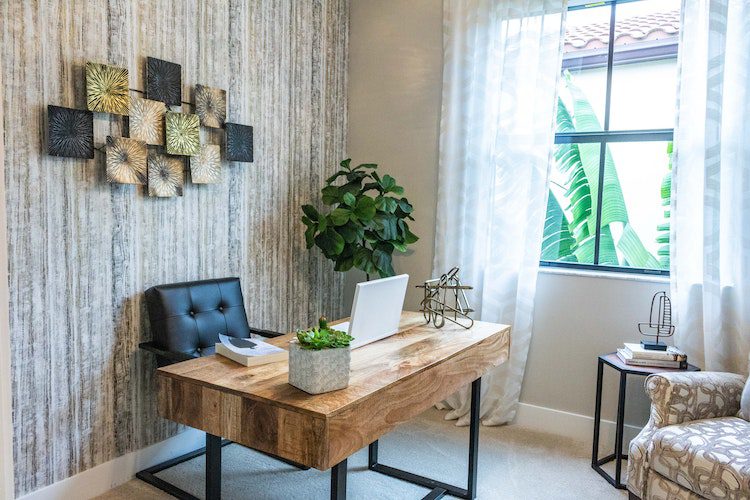8 Tips for Organizing Your Home Office

My guest blogger this month is Sarah Thompson a renowned productivity enthusiast and organizational expert. With over a decade of experience managing home offices, she has helped countless individuals transform their workspaces into efficient and inspiring environments.
Working from home has become increasingly common and having an organized home office has never been more crucial. Whether you’re a remote worker, a freelancer, or someone who needs a productive space to tackle personal projects, a well-organized workspace can significantly impact your efficiency and overall well-being. In this digital age where distractions lurk around every corner, taking the time to declutter, streamline, and optimize your home office is a wise investment. In this article, we will explore eight essential tips to help you transform your home office into a sanctuary of productivity and inspiration. From designating a dedicated workspace to implementing effective storage solutions, we will cover practical strategies to keep your office tidy, efficient, and conducive to focused work. So, if you’re ready to banish the chaos and create a harmonious work environment, let’s dive into these valuable tips for organizing your home office.

Designate a Dedicated Workspace
Designating a dedicated workspace is the first step toward organizing your home office. While working from the comfort of your bed or the couch may be tempting, having a separate and distraction-free area is essential for maintaining focus and productivity. Choose a location in your home that can be dedicated solely to work, whether it’s a spare room, a corner in the living room, or even a well-designed nook in the hallway. Consider factors like natural light, noise levels, and ergonomic setup when selecting your workspace. Creating a physical boundary between work and leisure areas signals to your brain that it’s time to concentrate and be productive. Additionally, having a designated workspace helps you mentally switch off from work when you’re done for the day, promoting a healthy work-life balance.

Declutter and Prioritize
Once you have designated a dedicated workspace, it’s time to declutter and prioritize. Skipping decluttering would be a big mistake. Clutter can be a major source of distraction and stress, hindering your ability to focus and work efficiently. Start by sorting and categorizing items in your home office, determining what is essential and what can be removed. Consider donating or disposing of items that no longer serve a purpose. Create a system for organizing papers, documents, and supplies, whether it’s using folders, binders, or storage containers. Prioritize frequently used items within easy reach while keeping less frequently used items neatly stored away. By decluttering and organizing your office space, you create a clean, streamlined environment that promotes productivity and a clear mind.
Establish Effective Storage Solutions
Establishing effective storage solutions is another crucial aspect of organizing your home office. Utilizing shelves, cabinets, and drawers can help keep your workspace tidy and minimize visual clutter. Storage containers and organizers are great tools for storing smaller items such as stationery, cables, and accessories. Labelling your storage containers and shelves ensures easy access and saves time when you need to find something specific. When it comes to organizing your home office, the experts at Phillips Moving and Storage recommend taking advantage of vertical space. Install floating shelves or wall-mounted organizers to maximize storage capacity without sacrificing valuable floor space. They also suggest utilizing stackable storage bins or drawers for efficient use of space. By incorporating smart storage solutions, you can create an organized and functional home office that supports your productivity and enhances your work environment.
Streamline Your Digital Workspace
Streamlining your digital workspace is equally important when organizing your home office. Digital clutter can be just as distracting as physical clutter, so take the time to organize your computer files and folders. Create a logical folder structure and label files appropriately for easy retrieval. Utilize cloud storage and backup options to free up space on your computer and ensure your files are securely backed up. Manage your email effectively by setting up folders and filters to categorize and prioritize incoming messages. Unsubscribe from unnecessary newsletters and regularly delete or archive old emails. By organizing your digital workspace, you’ll experience improved workflow, faster access to information, and reduced stress when navigating your virtual office environment.
Organizing your home office includes optimizing your desk setup
Optimizing your desk setup is essential for creating a productive and comfortable home office environment. Start by choosing the right desk and chair that provides adequate support and ergonomic features. Ensure that your desk is spacious enough to accommodate your work essentials and allow for the proper placement of your computer, keyboard, and other devices. Managing cables and cords is also important to maintain a tidy workspace and prevent tripping hazards. Use cable management solutions such as cable clips or cable sleeves to keep cords organized and out of the way. Remember, a well-optimized desk setup enhances your physical comfort and also contributes to your overall efficiency and focus when working from home.
Implement Time and Task Management Systems
Implementing time and task management systems is key to staying organized and productive in your home office. Utilize calendars and planners to schedule and prioritize your tasks effectively. Set realistic deadlines and break larger projects into smaller, manageable tasks. Consider using productivity apps or software to help you track your progress and stay focused. Establishing a routine can also be beneficial in creating a sense of structure and discipline. Determine your most productive hours and allocate specific time slots for focused work, breaks, and other activities. By implementing time and task management systems, you can enhance your productivity, meet deadlines, and maintain a sense of control over your workload in your home office.

Maintain a Clean and Inspiring Environment
Maintaining a clean and inspiring environment is crucial for the long-term success of your home office organization. Establish regular cleaning and decluttering routines to prevent the buildup of unnecessary items and dust. Incorporate plants and natural elements into your workspace to enhance air quality and create a calming atmosphere. Personalize your space with meaningful decor, inspiring artwork, or motivational quotes to boost creativity and motivation. Remember, a clean and inspiring environment not only uplifts your mood but also fosters a sense of pride and ownership in your home office, making it a place where you can thrive and achieve your professional goals.
Establish boundaries
Another important tip for organizing your home office is establishing clear boundaries between your work and personal life. When working from home, it’s easy for the lines to blur, leading to potential distractions and a lack of work-life balance. Set specific work hours and stick to them, allowing yourself designated time for breaks and personal activities. Create a physical separation, if possible, by closing the door to your home office or using a room divider. Communicate your work schedule to family members or roommates so they understand when you need uninterrupted focus. By establishing clear boundaries, you can maintain a sense of structure and ensure that your home office remains a dedicated space for work, ultimately increasing productivity and reducing stress.
In conclusion
Organizing your home office is vital to creating a productive, efficient, and inspiring workspace. By designating a dedicated area, decluttering and prioritizing your belongings, implementing effective storage solutions, streamlining your digital workspace, optimizing your desk setup, and establishing time and task management systems, you can transform your home office into a well-organized oasis of productivity. Maintaining a clean and inspiring environment and setting clear boundaries between work and personal life will also contribute to your overall success and well-being. Embrace the benefits of an organized workspace, and watch as your productivity, focus, and enjoyment soar to new heights. Get started today and create a home office that sets the stage for your best work yet!
I think she covered all the information well. Please add a comment about organizing your home office that makes you more productive.

Julie Stobbe is a Trained Professional Organizer and Lifestyle Organizing Coach who brings happiness to homes and organization to offices, coaching you virtually using Zoom. She has been working with clients since 2006 to provide customized organizing solutions to suit their individual needs and situations. She uses her love of teaching to reduce clutter, in your home, office, mind and time. She guides and supports you to be accountable for your time, to complete projects and to reach your goals. If you’re in a difficult transition Julie can coach you to break-free of emotional clutter constraining you from living life on your terms. Online courses are available to help instruct, coach and support your organizing projects. Get started by downloading Tips for Reorganizing 9 Rooms.
Contact her at julie@mindoverclutter.ca


I love that you mentioned having a separate home office. While it is convenient to have your dining room table as an office, it is not a productive area. I like to have a home office where I place all my things, and if I want to change scenery, I usually go into our three-season room to be creative and write. Having different areas in your home to allow you to move around helps with those writer’s block moments we all have from time to time.
Thanks for your comment. I agree having a designated place for all you papers, projects and laptop and to work help to prevent distractions and lack of focus. Being able to move to other spaces is a great way to refocus your attention when you are having trouble solving a problem.
My home office is a spare bedroom, and I’m thankful to have the space available. But I’ve seen other home offices that were much “cooler” – one was set up in the upstairs hallway of a large old house!
Yes an office can be in any space. I have seen a closet converted to an office and a desk cupboard that opens up and is a complete office and then closes to look like a wardrobe.
One lightbulb for me is the idea that I can have multiple workstations. In my case, a lot of my “storage” is in my kitchen, at my desk. Unfortunately, this isn’t a great space to sit down and work: there is traffic in the kitchen, the ergonomics of the desk aren’t good, etc. I found myself not wanting to sit at my desk!
Instead, I found I liked sitting at a (largely decorative) secretary desk we have in our living room. It is quiet in this room, and the height of the desk relative to the chair is more comfortable for me. All I needed to do to make this a good space for writing and conducting my coaching calls was to add a hard-wire internet connection. We have a lot of people drawing our our wifi, and this was necessary for me to be productive.
I still store most of my physical work things in the kitchen desk, but when I’m ready to sit down and focus, I head into the living room. So far, so good!
I enjoy hearing how you make your work space suit your personality and living space. I do believe the idea of having a designated storage space is important so you don’t lose anything and you can put it away and feel like your work day has ended. My office has a huge window and when I open it I feel like I am outside. It has really helped me to be able to work in the summer, feeling the warm breeeze and hearing the birds.
Having a dedicated workspace makes all the difference. But it’s not just about having the space, but about what you do with it. Organizing it in a way that supports your needs is essential. I had a designated office space for years, but it didn’t function well. As a gift, my husband worked with me to design and build my ideal “Linda space.” It has everything I need, is beautiful to work in, has good lighting and ergonomic design, and is in my favorite colors. I’m happy to sit, work, and create at my desk.
It makes a difference.
A lot of people put their office in the “empty” space in their home not the space they would like to spend time in. Having an office space you want to be in makes work enjoyable and increases productivity.
If you’re curious, here is the post I wrote about my office transformation: https://www.ohsoorganized.com/blog/2013/8/13/dreams-need-help-too.html.
Thanks for sharing this link.
It is really important to have that separate space for work. Haven’t we all been forced to do it during the start of the pandemic? some still work from home and some this is what they chose to do, to minimize commute. Making the space inviting to your liking will definitely make the work more enjoyable.
I think during Covid people continued to think” it will be over soon” and made do with a space or many spaces around the house. Now that working from home is a “real” option setting up a good workspace is essential.
Hi Julie,
This is such great timing for me. We are in the process of making some changes in my fairly new office space. My partner is joining me in this space. I am thinking about some floating shelves for her above her desk. As long as I can keep them from looking crazy cluttered. lol I usually go to my office for zoom calls but would like to use it more consistently. When my house is quiet I also like sitting at my bar (not that kind of bar lol) but it is nice and sunny there in the morning and I kind of love it. Thanks for the post.
I have floating shelves 12 inches above my desk to hold staplers, 3 hole punch,kleenex etc so my desk is clear for work but everything I need is within reach. My office has a large window that I open and I feel like I am outside even though I am inside working. It feels like I can enjoy summer and keep working.
I love that this references considering “natural light, noise levels, and ergonomic setup” when selecting a workspace, because all too often, people default to whatever space is nearest an outlet or wherever the desk they bought can fit. The older I get, the more I recognize the value of ergonomics in the design of an at-home work space, and I’m contemplating changes I need to make now and in the future. I’m also in agreement that physical boundaries between the work/play areas of your home help differentiate between when and where to be focused.
Thank you for your comments. People usually do use an empty space not needed for anything else instead of picking a place they would like to work. The office space is then not used and papers and computers end up all over the house.